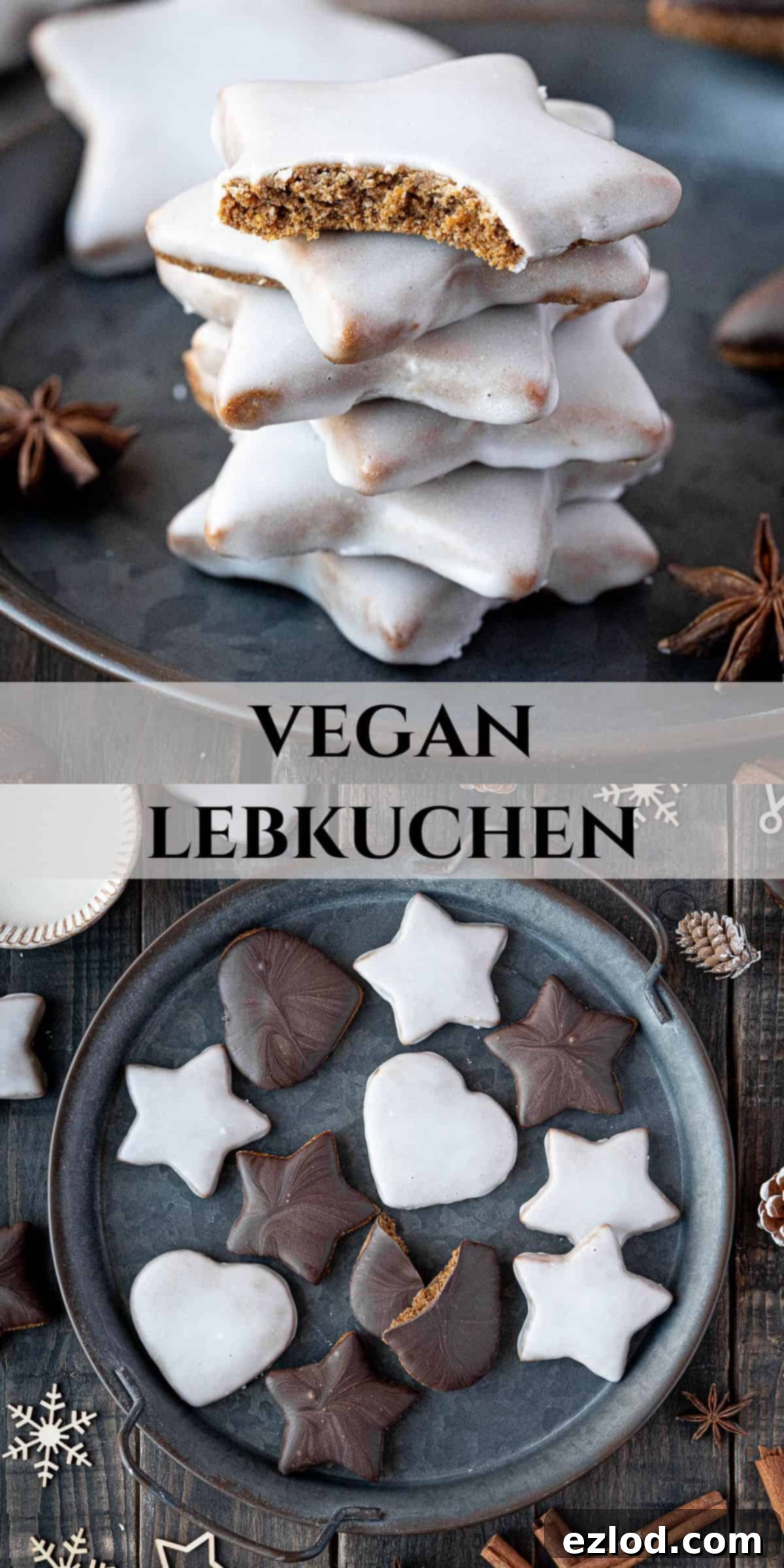Vegan Lebkuchen: The Ultimate Guide to Soft, Spicy German Gingerbread Cookies
Embrace the festive spirit with these delightful vegan Lebkuchen – soft, chewy, and wonderfully spicy German gingerbread cookies. Perfectly crafted for the holiday season, these plant-based treats are not only easy to make but also burst with traditional yuletide flavors. Their excellent shelf life makes them ideal for thoughtful gifting or simply for enjoying as a festive snack throughout December.
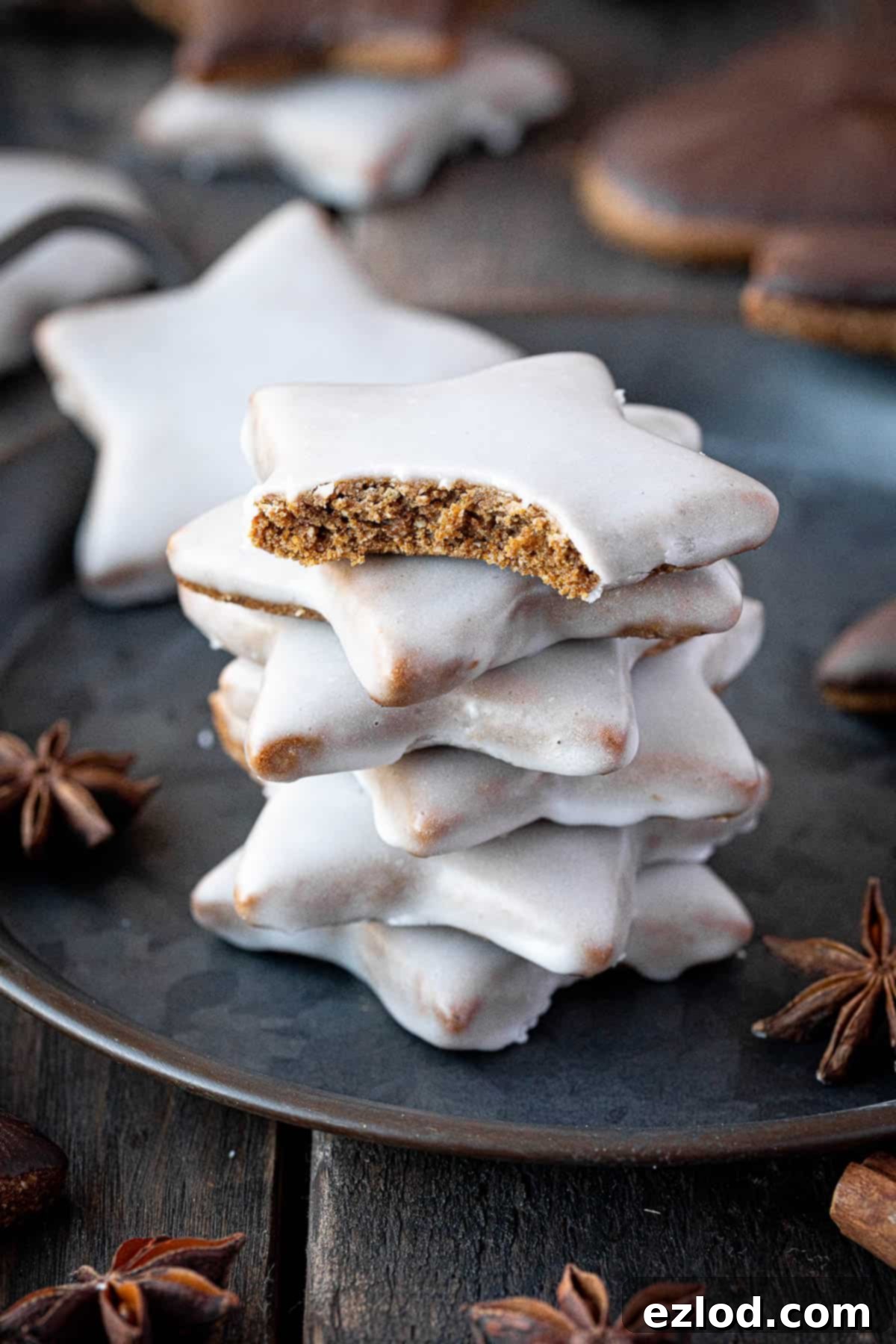
When most people think of German Christmas cookies, Lebkuchen often comes to mind. While there are several varieties of these traditional German treats, the most widely recognized outside of Germany are similar to gingerbread cookies but boast a distinctive soft, cake-like, and wonderfully chewy texture. They also feature a unique and complex blend of spices that sets them apart.
It’s this beloved, cakey style of Lebkuchen that I set out to veganize. While you might occasionally stumble upon accidentally vegan versions at supermarkets like Aldi or Lidl during the holiday season, nothing quite compares to the rich flavor and satisfying texture of homemade Lebkuchen. This recipe offers a straightforward approach to creating warmly spiced, incredibly addictive vegan Lebkuchen that will become a staple in your festive baking repertoire.
To finish these beautiful cookies, I love to divide them. Half receive a delicate, tangy lemon glaze, adding a bright contrast to the warm spices, while the other half are dipped in luxurious melted chocolate, providing a rich, decadent touch. Feel free to choose one topping or enjoy a mix of both, depending on your preference!
Why You’ll Love This Vegan Lebkuchen Recipe
There are countless reasons to make these homemade vegan Lebkuchen a part of your holiday tradition:
- Authentic Flavor: This recipe captures the classic taste of traditional German Lebkuchen, with its signature blend of warming spices.
- Perfect Texture: Expect a soft, moist, and delightfully chewy cookie that melts in your mouth – a true hallmark of excellent Lebkuchen.
- Completely Plant-Based: Enjoy these festive treats knowing they are entirely vegan, making them suitable for a wider range of dietary preferences without compromising on taste.
- Easy to Make: Despite their impressive appearance and complex flavor, the process for making these cookies is surprisingly simple and accessible for bakers of all skill levels.
- Wonderful for Gifting: Lebkuchen keeps exceptionally well, making them perfect for homemade holiday gifts for friends, family, and neighbors.
- Versatile Decorating: Whether you prefer a zesty lemon glaze or a rich chocolate coating, these cookies offer versatile options for a beautiful finish.
- A Taste of Tradition: Bring a piece of German Christmas tradition into your home with these beloved holiday cookies.
Essential Ingredients for Your Vegan Lebkuchen
Crafting the perfect vegan Lebkuchen requires a thoughtful selection of ingredients. Here’s a breakdown of what you’ll need and why each component is important:
Sticky Sweeteners: Golden Syrup and Treacle (Molasses)
Traditionally, Lebkuchen gets its unique sweetness and depth from honey. To achieve a delicious vegan alternative, we use a combination of golden syrup and treacle. Golden syrup provides a lovely golden hue and a smooth, buttery sweetness, while treacle (or molasses in the US) adds a richer, slightly bitter, and more complex depth of flavor that is essential for authentic Lebkuchen taste. If you can’t find both, using all golden syrup is an option, but the treacle truly elevates the flavor profile. For those in the US, molasses is the equivalent of treacle, and agave or maple syrup can be used as a substitute for golden syrup if it’s unavailable, though they may slightly alter the final taste and texture.
Vegan Butter: Choose Wisely!
This is a crucial ingredient for the right cookie texture. Please, for successful baking, always opt for a block-style vegan butter or margarine. These are formulated to behave more like dairy butter in baking, providing the necessary fat content and structure. Avoid spreadable vegan butter from tubs, as they contain a higher water content and less fat. Using spreadable butter will likely result in a dough that is too soft and cookies that might be tougher or spread excessively during baking. Brands like Naturli Vegan Block or Flora Plant Butter are excellent choices.
Plain Flour (All-Purpose Flour)
Regular plain (all-purpose) wheat flour works best for this recipe, providing the ideal structure for these cakey cookies. I haven’t experimented with gluten-free alternatives for this particular recipe, so I cannot guarantee results if you choose to substitute.
Ground Almonds (Almond Flour)
Ground almonds are an essential component, contributing significantly to the characteristic soft, moist, and slightly cakey texture of Lebkuchen. In the US, this is commonly referred to as almond flour. If almonds are not an option, ground hazelnuts can be used as an alternative, offering a slightly different but equally delicious nutty flavor.
Brown Sugar
Either light or dark brown sugar will work perfectly here. Brown sugar not only adds sweetness but also contributes moisture and a subtle caramel note that complements the rich spices and sticky syrups.
The Spice Blend: Lebkuchengewürz (or Individual Spices)
Lebkuchen are famous for their unique spice profile, traditionally achieved with a blend called “Lebkuchengewürz.” This blend can be difficult to source outside of Germany. This recipe provides an excellent homemade blend using individual spices: cinnamon, ginger, nutmeg, allspice, cloves, cardamom, and coriander. Each spice plays a vital role: cinnamon and ginger provide warmth, nutmeg and allspice add depth, cloves offer a pungent sweetness, cardamom brings an exotic floral note, and coriander adds a hint of citrusy earthiness. Together, they create the unmistakable festive aroma and flavor of Lebkuchen.
Leavening Agents: Baking Powder and Baking Soda
Both baking powder and bicarbonate of soda (baking soda) are crucial for achieving the desired cakey and soft texture. They are not interchangeable; baking soda reacts with acidic ingredients (like brown sugar and treacle) to create lift, while baking powder provides additional leavening. Using both ensures a balanced rise and tender crumb.
Orange Zest
While optional, the finely grated zest of an orange (or even a lemon) adds a bright, fragrant, and wonderfully citrusy note that beautifully enhances the complex spice blend. It elevates the overall flavor, making the cookies even more aromatic and festive.
Non-Dairy Milk
Any unflavored non-dairy milk will work well to bring the dough together. I typically use soy milk, but almond, oat, or rice milk are also suitable. Avoid tinned coconut milk as its high-fat content and strong flavor are not ideal for this recipe.

How To Make Irresistible Vegan Lebkuchen: A Step-by-Step Guide
(For precise measurements and detailed instructions, please refer to the comprehensive recipe card located at the bottom of this page.)
Making these vegan Lebkuchen is a straightforward process that yields incredibly rewarding results. Follow these steps for perfect festive cookies:
- Melt the Wet Ingredients: Begin by combining the golden syrup, treacle, vegan block butter, and brown sugar in a saucepan. Heat this mixture gently over low heat, stirring occasionally, until all the ingredients have fully melted and are smoothly combined.
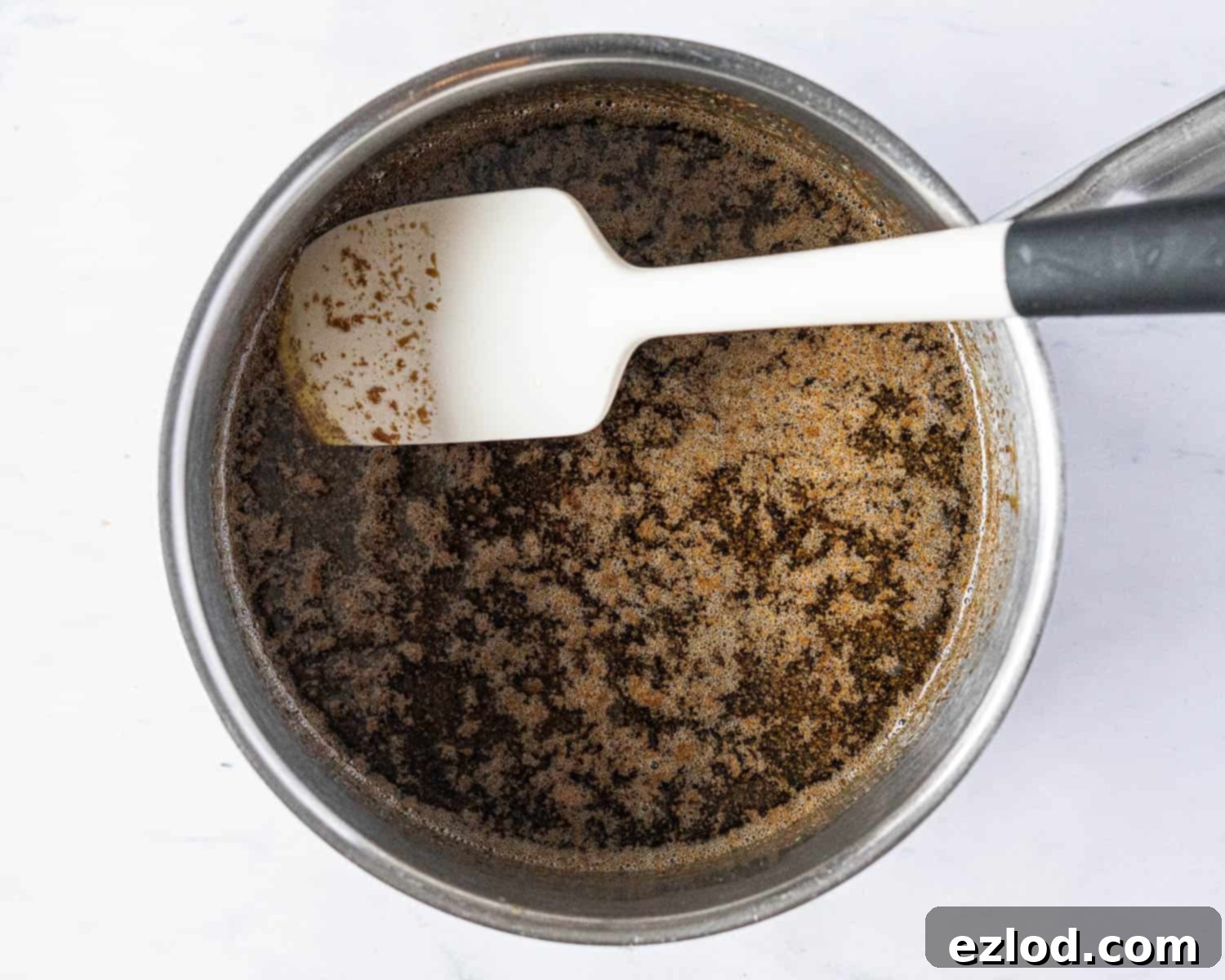
- Incorporate the Aromatics: Remove the pan from the heat. Into the warm mixture, whisk in the ground almonds, non-dairy milk, orange zest, baking powder, bicarbonate of soda, salt, and all your aromatic ground spices (cinnamon, ginger, allspice, nutmeg, cloves, cardamom, and coriander). Stir until well combined and fragrant.
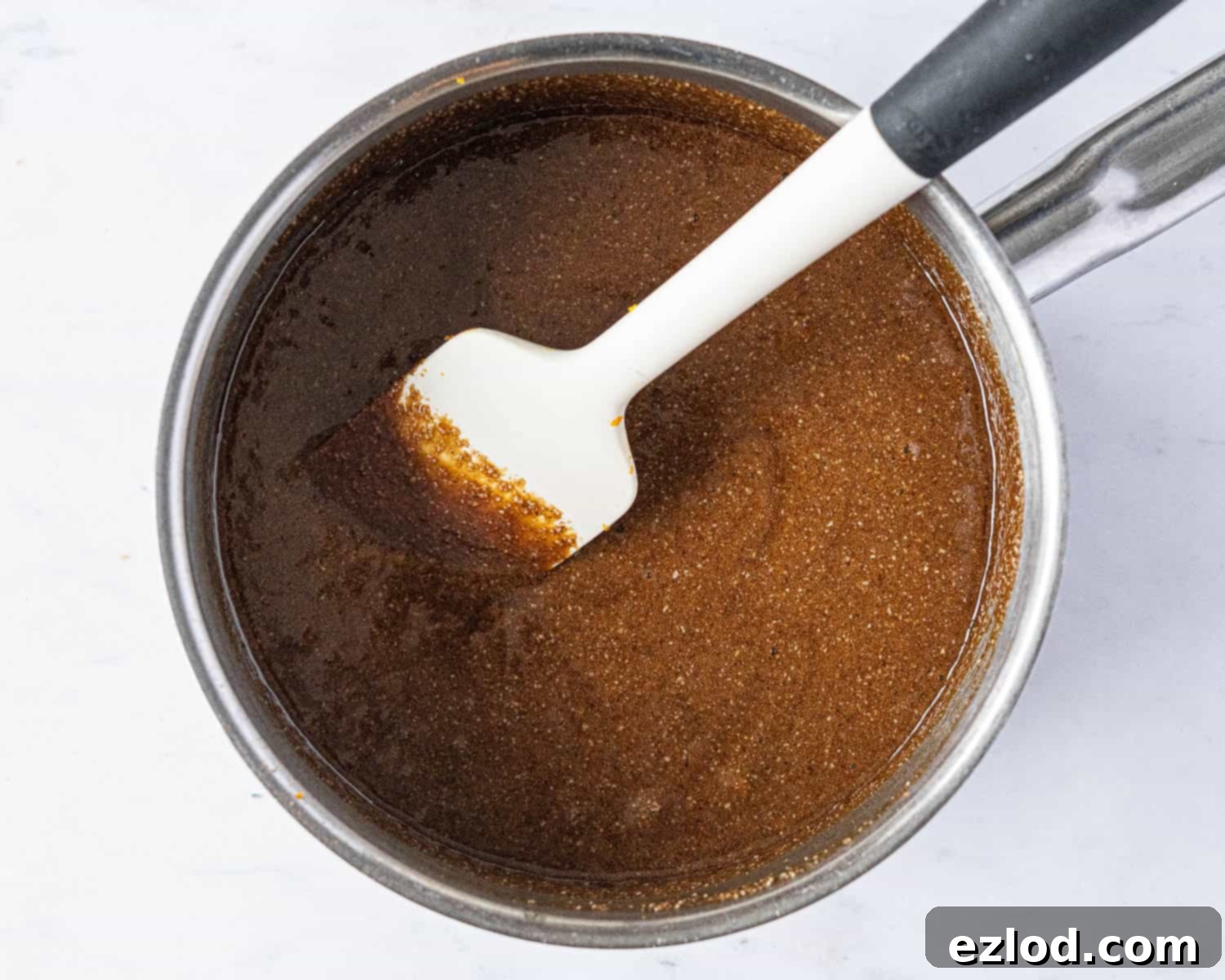
- Form the Dough: Add the plain flour to the mixture. Stir thoroughly with a wooden spoon or spatula until a soft, sticky dough forms. Be careful not to overmix; just combine until no dry streaks of flour remain.
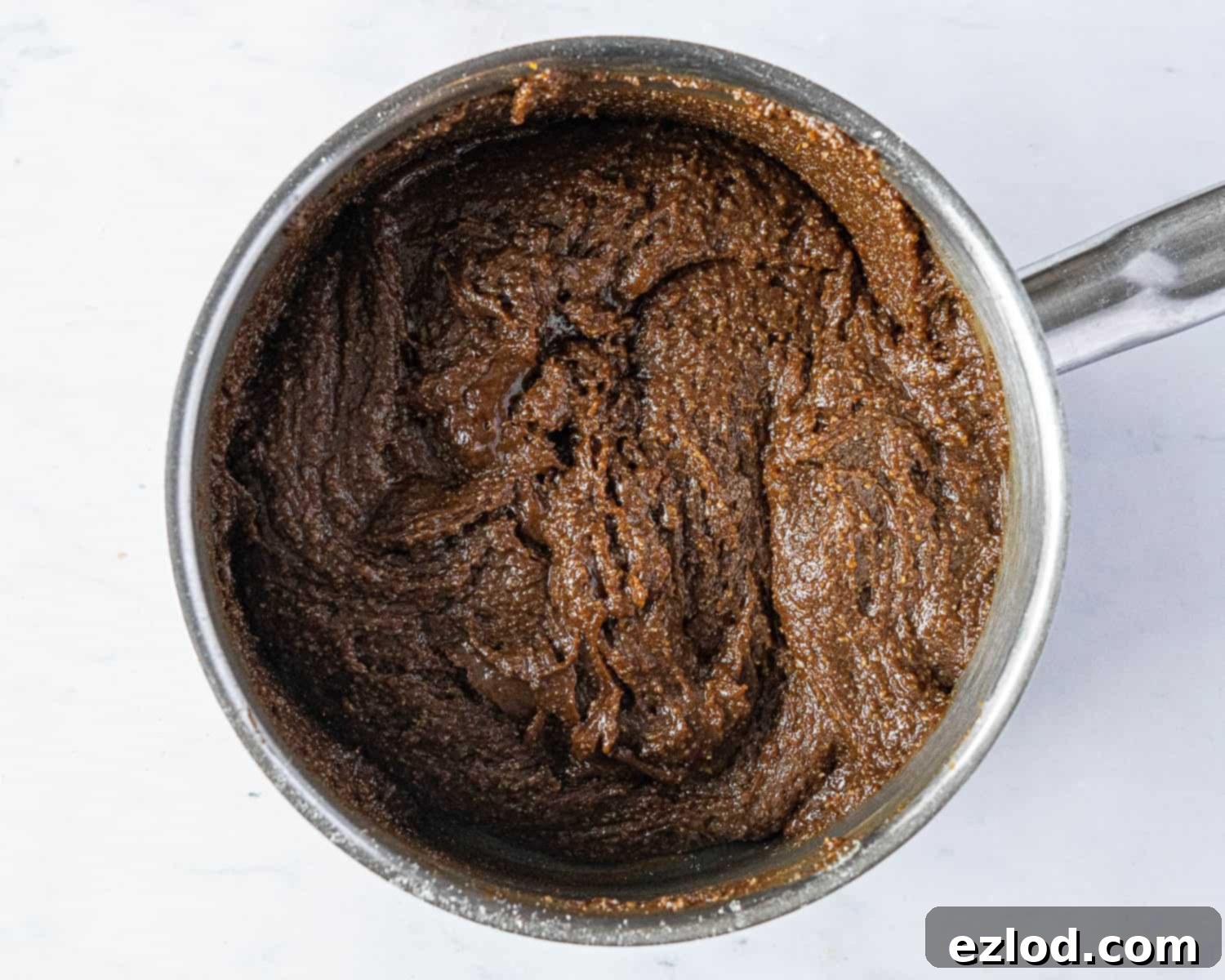
- Chill the Dough: Scrape the sticky dough into a clean bowl, cover it tightly with plastic wrap or a lid, or wrap it in baking parchment. Refrigerate the dough for at least two hours, and ideally overnight. Chilling is crucial as it allows the dough to firm up, making it much easier to roll out and cut.
- Preheat Oven & Prepare Trays: When ready to bake, preheat your oven to 180°C/160°C fan/350°F/gas mark 4. Line two baking sheets with baking parchment to prevent sticking and ensure even baking.
- Roll and Cut: On a lightly floured surface, roll out the chilled dough to a thickness of about 6-10mm. The thickness will determine how soft or slightly firmer your Lebkuchen turn out; I typically aim for around 7-8mm for a perfect chewy consistency.
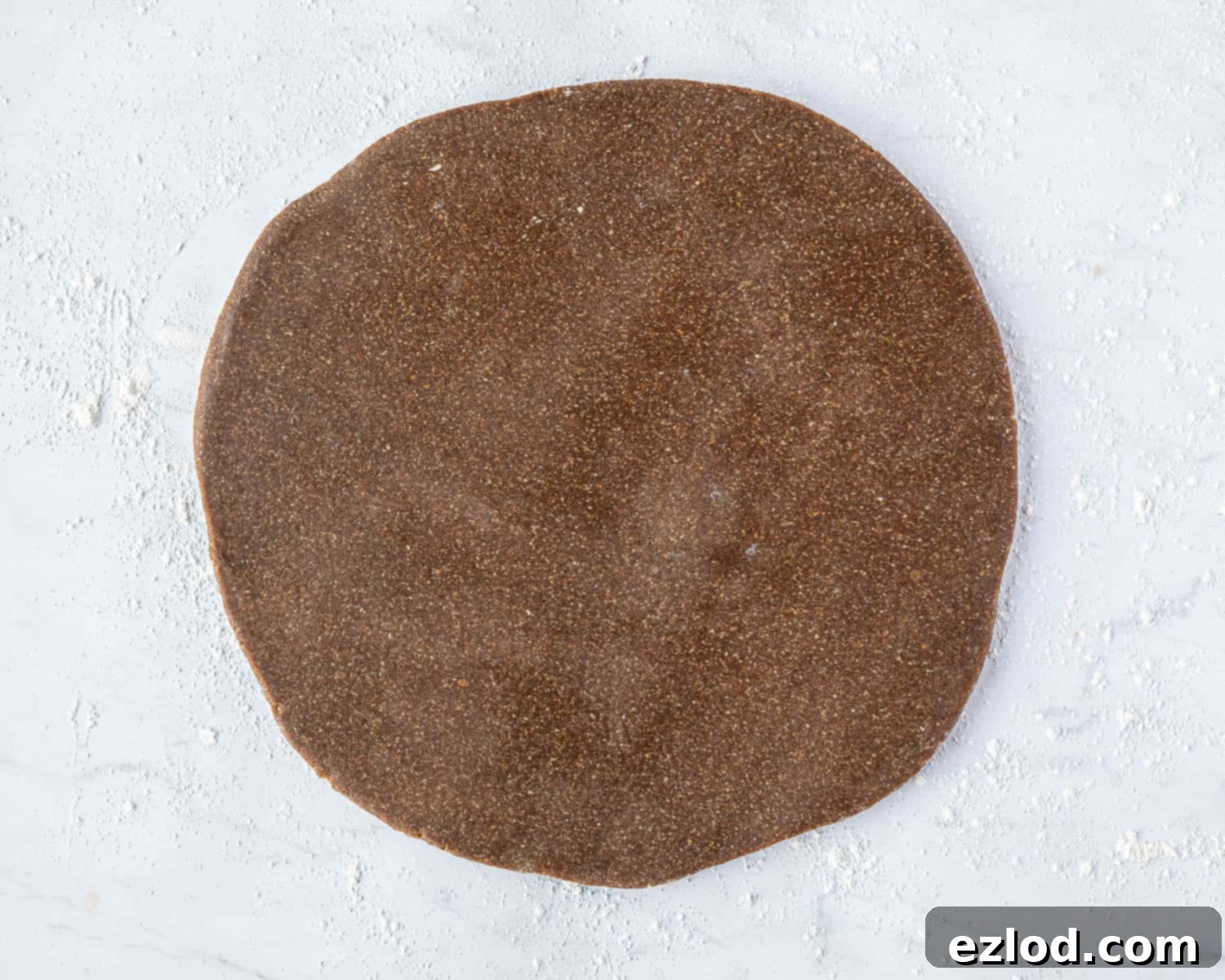
- Cut the Cookies: Use your favorite festive cookie cutters (stars, hearts, circles work well for these cakey cookies) to cut out as many shapes as possible from the rolled dough. Carefully place the cut-out cookies, spaced well apart, onto your prepared baking sheets. Gather the dough scraps, gently re-roll them, and cut out more cookies until all the dough is used.

- Bake to Perfection: Bake the Lebkuchen for 10-15 minutes. They are ready when their edges are lightly browned and the surface of the cookies no longer appears wet or glossy. Be careful not to overbake, as this can make them crunchy instead of soft and chewy.

- Cool the Cookies: Once baked, allow the Lebkuchen to cool on the baking trays for a few minutes. They will be delicate when warm. Then, carefully transfer them to a wire rack to cool completely before glazing or decorating.

- Prepare the Glaze: Once the Lebkuchen are completely cool, prepare your glaze. For a lemon glaze, whisk sifted icing (powdered) sugar with lemon juice in a small bowl until it forms a smooth, runny consistency. For a chocolate coating, gently melt dark chocolate in a double boiler or microwave.
- Glaze and Set: Dip the tops of the cooled Lebkuchen into your chosen glaze or melted chocolate. Allow any excess to drip off, then place them back on the wire rack. Let the glaze or chocolate set completely before storing.
Expert Tips for Baking Flawless Vegan Lebkuchen
Achieving bakery-quality vegan Lebkuchen is easy with a few key insights. Here are my top tips to ensure your festive cookies are absolutely perfect every time:
Measure with Precision: Go Metric!
As with all my baking recipes, I wholeheartedly recommend using metric measurements with a digital kitchen scale over volumetric cup conversions. Cups are notoriously inaccurate due to variations in how ingredients are packed, leading to inconsistent results. A digital scale ensures precise measurements, which is crucial for the delicate balance of fats, sugars, and flours in cookies. Not only will your Lebkuchen turn out perfectly every time, but using a scale is also often quicker and less messy!
Avoid Overbaking for Perfect Texture
The hallmark of excellent Lebkuchen is their soft, chewy, and cakey texture. Overbaking is the quickest way to ruin this, turning your cookies hard and crunchy. Keep a close eye on them in the oven. They are ready when the edges are lightly golden and the center no longer looks wet. If in doubt, it’s better to underbake slightly than to overbake.
Choose Simple Cookie Cutter Shapes
Since Lebkuchen are cakey and tend to be a bit thicker and softer than traditional crisp gingerbread, stick to simple, sturdy cookie cutter shapes. Stars, hearts, circles, or even squares work beautifully and maintain their form well during baking. Intricate designs might lose definition or be challenging to handle.
The Importance of Chilling the Dough
Don’t skip the chilling step! The dough needs to firm up significantly before you attempt to roll it out. Chilling for at least a couple of hours, or ideally overnight, makes the dough much easier to handle, less sticky, and prevents excessive spreading in the oven. Plan your baking day accordingly so you have ample chilling time.
Alternative Shaping Method: Rolled Balls
If you’re short on time or prefer a more rustic look, you don’t necessarily have to roll and cut the dough. Instead, you can pinch off small pieces of chilled dough (about a tablespoon each), roll them into balls between your palms, and then slightly flatten them before placing them on lined baking sheets. Bake as directed.
Coconut Oil as a Vegan Butter Alternative
In a pinch, you can use solid coconut oil instead of vegan block butter. However, be aware that coconut oil tends to become very firm when chilled. If your dough becomes too hard to roll out after chilling, let it sit at room temperature for a short while (15-30 minutes) to soften slightly before working with it. Ensure it’s not too warm, though, or it will be too sticky.
Accurately Weigh Golden Syrup and Treacle
The precise amounts of golden syrup and treacle are crucial for the dough’s consistency. Even a difference of a few grams can impact the stickiness of the dough and how much your cookies spread during baking. Always use a digital scale for these sticky liquids to ensure accuracy.
Bake Test Cookies
Oven temperatures can vary, and the ideal bake time will depend on your oven, the size and thickness of your cookies, and your desired level of softness. To avoid a batch of over or underbaked cookies, I highly recommend baking a couple of test cookies first. This will help you determine the perfect bake time for your specific conditions.
To Temper Chocolate or Not To Temper?
If you’re glazing some Lebkuchen with chocolate and desire a perfectly shiny, snappy finish that doesn’t melt easily at room temperature, you would need to temper the chocolate. However, tempering can be quite a “faff” (a hassle) and is particularly challenging with small quantities of chocolate. For home baking, I usually don’t bother with tempering. A simple melted chocolate dip tastes just as good, even if it’s not perfectly glossy. (And honestly, I’m not very good at tempering!).
Glaze Variations
While a simple lemon glaze is wonderfully refreshing, feel free to experiment with other liquid bases for your icing sugar glaze. A mixture of rum and water can add a sophisticated, boozy flavor, perfect for adult palates during the holidays.

How To Store Vegan Lebkuchen:
One of the best qualities of Lebkuchen is how well they keep! Store your finished cookies in an airtight container at room temperature. They will remain fresh and delicious for 2-3 weeks. To prevent sticking, especially if glazed, separate layers of cookies with pieces of greaseproof paper (parchment paper). Ensure any glaze or chocolate coating is completely dry and set before stacking them.
Can I Freeze The Dough?:
Yes, the vegan Lebkuchen dough freezes beautifully! Once you’ve prepared the dough and before rolling it out, wrap it tightly in baking parchment or cling film, then place it in a freezer-safe bag or container. It can be frozen for up to 3 months. When you’re ready to bake, transfer the frozen dough to the fridge to defrost overnight. Then, let it come up to room temperature for a bit before rolling it out and baking as usual.
How Long Will The Dough Keep In The Fridge?:
The prepared Lebkuchen dough can be stored, well-wrapped in a silicone bag or cling film, in the fridge for up to three days. This makes it perfect for preparing ahead of time. You may need to let it sit at room temperature for 15-30 minutes before it becomes pliable enough to roll out.
More Vegan Christmas Cookies to Try
If you’ve loved these vegan Lebkuchen, explore more festive plant-based baking with these other delicious recipes:
- Vegan Vanillekipferl
- Vegan Chocolate Pistachio Biscotti
- Vegan Gingerbread Biscotti
- Vegan Biscotti with Almonds and Cranberries
- Vegan Chocolate Orange Shortbread
- Vegan Cranberry Orange Shortbread
- Vegan Pecan Snowball Cookies
- Vegan Nussecken
- Vegan Linzer Cookies
- Vegan Shortbread Fingers
- Vegan Gingerbread Cookies
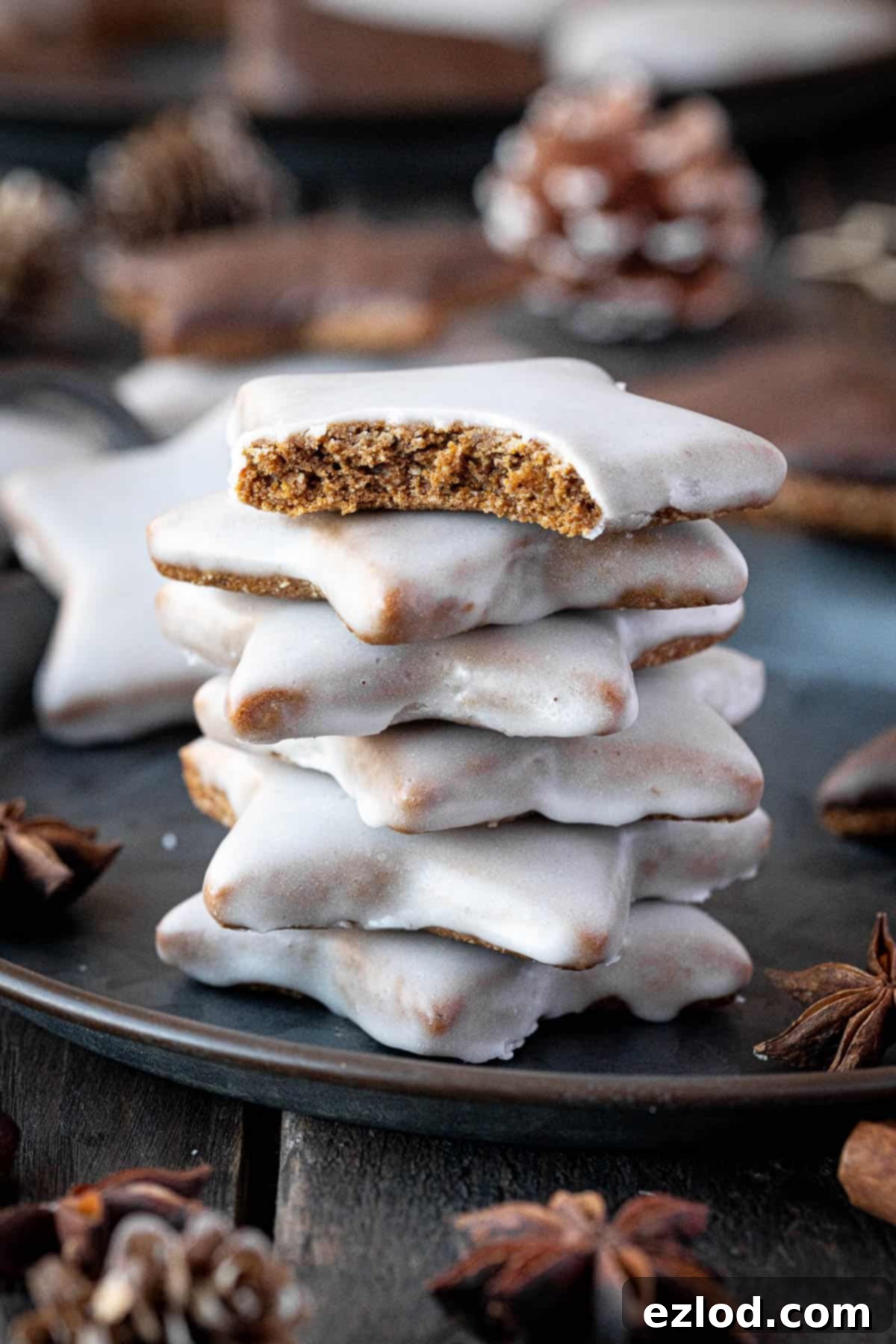
If you tried this recipe, I’d love to hear how it went! Please rate it, leave a comment below, or tag @domestic_gothess on Instagram and use the hashtag #domesticgothess to share your creations!
All images and content on Domestic Gothess are copyright protected. If you wish to share this recipe, please do so by using the provided share buttons. Do not screenshot or post the recipe or content in full; instead, kindly include a link back to this post for the complete recipe. Thank you for your understanding and support!

Print
Vegan Lebkuchen
Ingredients
For the Lebkuchen Dough:
- 100 g (4 ½ Tablespoons) golden syrup
- 100 g (4 ½ Tablespoons) treacle (or molasses in the US)
- 90 g (⅓ cup + 1 Tablespoon) vegan block butter (NOT spreadable. Naturli or Flora Plant Butter recommended)
- 50 g (¼ cup) brown sugar
- 100 g (1 cup) ground almonds (or almond flour)
- 2 Tablespoons non-dairy milk (e.g., soy, almond)
- finely grated zest of 1 orange or lemon
- 1 teaspoon baking powder
- ½ teaspoon bicarbonate of soda (baking soda)
- 2 teaspoons ground cinnamon
- 1 teaspoon ground ginger
- ½ teaspoon ground allspice
- ½ teaspoon ground nutmeg
- ¼ teaspoon ground cloves
- ¼ teaspoon ground cardamom
- ¼ teaspoon ground coriander
- ¼ teaspoon salt
- 250 g (2 cups) plain (all-purpose) flour
For the Glaze and Decoration:
- 150 g icing (powdered) sugar sifted
- 2 Tablespoons lemon juice (or a mix of rum and water)
- 150 g dark chocolate melted (optional, for dipping)
Instructions
-
In a medium saucepan, combine the golden syrup, treacle, vegan block butter, and brown sugar. Heat gently over low heat, stirring until completely melted and smooth.
-
Remove the pan from the heat. Whisk in the ground almonds, non-dairy milk, orange zest, baking powder, bicarbonate of soda, all the ground spices (cinnamon, ginger, allspice, nutmeg, cloves, cardamom, coriander), and salt until fully incorporated and fragrant.
-
Add the plain (all-purpose) flour to the mixture. Stir with a wooden spoon or spatula until a soft, sticky dough forms. Be careful not to overmix.
-
Scrape the dough into a bowl and cover it tightly, or wrap the dough itself in baking parchment. Refrigerate for at least 2 hours, or ideally overnight, until the dough is firm enough to roll.
-
Preheat your oven to 180°C/160°C fan/350°F/gas mark 4. Line two large baking sheets with baking parchment.
-
On a lightly floured surface, roll out the chilled dough to an even thickness of 6-10mm. (For a good balance of soft and chewy, aim for around 7-8mm).
-
Use your desired cookie cutters to cut out shapes from the dough. Place the cut-out cookies on the prepared baking sheets, ensuring they are well spaced apart. Gather any dough scraps, gently re-roll, and cut out more cookies until all the dough is used.
-
Bake the Lebkuchen for 10-15 minutes. They are ready when the edges are lightly browned and the surface of the cookies no longer appears wet. Be careful not to overbake to maintain their soft, chewy texture.
-
Allow the cookies to cool on the baking trays for a few minutes to firm up slightly, then carefully transfer them to a wire rack to cool completely before decorating.
-
For the lemon glaze: place the sifted icing (powdered) sugar in a small bowl and gradually stir in the lemon juice until a smooth, runny glaze forms. For chocolate: gently melt the dark chocolate.
-
Dip the tops of the cooled Lebkuchen into the glaze or melted chocolate. Allow any excess to drip off, then place them back on the wire rack until the glaze or chocolate has fully set. Once set, store the decorated Lebkuchen in an airtight container at room temperature.
Notes
- For more detailed tips, ingredient information, and step-by-step photos, please refer to the main article above the recipe card.
- For best and most consistent baking results, I strongly recommend using metric measurements with a digital kitchen scale instead of cup conversions. Measuring by weight is far more accurate and will lead to better cookie texture.
